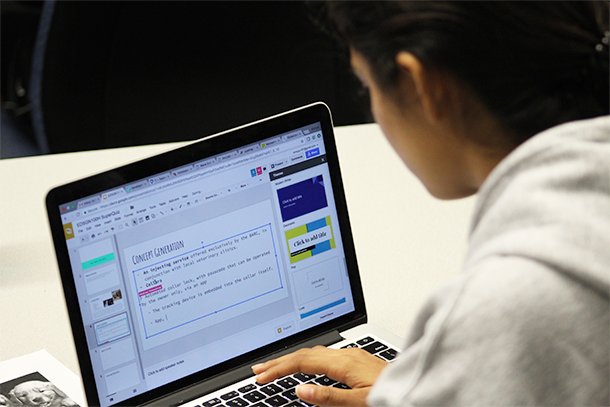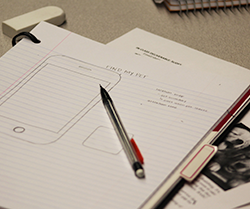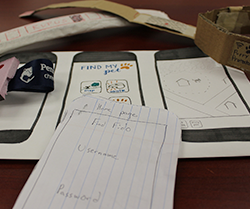
For their EDSGN 100H design practicums, student teams were asked to provide summaries of how they went about generating concept ideas and how they selected an idea to prototype.
Quiz [re]design: Rethinking engineering design evaluation
Unique design practicum tests first-year engineering students' engineering design process comprehension and application capabilities
03/22/18
UNIVERSITY PARK, Pa. – To combat design creation and execution limitations placed on students by traditional quizzes, Christopher McComb, assistant professor in engineering design and mechanical engineering, presented his EDSGN 100H: Introduction to Engineering Design students with a unique challenge — a design practicum.
Instead of a conventional pen and paper knowledge test, McComb asked his students to showcase their understanding of engineering design concepts — problem definition, customer needs, concept generation, concept selection and detailed design and prototyping – through a group design challenge.
McComb, who also holds a courtesy appointment in industrial engineering, provided his students with a design brief where the fictional Boalsburg Animal Rescue Colony requested the development of a product or service that tracks pets, allowing lost animals to be found and returned home quickly and easily. Because of its capabilities, the product would eventually lead to a decreased number of animals at the rescue shelter.
Students were given one class period to design and prototype their pet-tracking products or services. Final projects included a presentation with a defined scenario, customer needs, a short description of the concept generation and selection processes and details for the final concept, including any prototyping information. McComb also requested an out-of-class reflection to be completed by each student. The reflection focused on the team’s design process and reviewed the team’s work.
“Going through a design challenge is useful in itself, because more and more companies are using case-based interviews, but the reflective element gives students a rare chance to analyze what they did and how to do better next time," McComb said. "Reflection encourages meta-cognition, or 'thinking about thinking,' and that in turn improves learning. I want my students to understand their strengths and weaknesses in design and use that self-awareness to be better learners and designers.”
Emmeline Evans, a first-year engineering student, described the design practicum more as a timed design challenge that allowed students to immediately apply engineering design concepts to create a product or service.
“Actually applying the concepts we learned in class was more exciting, more fun and more difficult than just answering questions about design,” she said. “It was a better test of whether we truly understood what we had learned. It is much more challenging to use the concepts to create something new than to recite and describe them.”
Nicholas Pantelis, a first-year engineering student, agreed, stating that McComb’s design practicums provide students with opportunities to solve issues that impact the real world. He said it’s fascinating that though he and his peers followed the same basic process to fix a problem, each team arrived at a different conclusion.
“It’s interesting to hear the different thought processes teams had when following the design process that led them to their conclusion,” he said. “Just because we all followed a similar design process doesn’t mean we produced the same outcome, and to listen to what others did adds to your bank of knowledge for the future.”
During the design process, Pantelis’ team worked through the concept generation and concept selection stages to ultimately prototype a basic adjustable collar that would include GPS tracking that is monitored through a mobile application. After defining the next steps in the process and reflecting on their application of the design process, Pantelis said he and his team members were able to better review and critique their work, something that isn’t possible on a traditional quiz.
“With the design practicum and subsequent reflection; however, we were asked to fully analyze our performance. This caused me to really self-reflect and critique how I performed. Consequently, I felt much more informed as to how to alter my actions in the future after a design practicum than after a typical quiz,” he said.
Evans agreed, stating that the design practicum experience is a more impactful way to display an understanding of the engineering design process.
“In my eyes, the design process is like streamlined, creative problem-solving and problem-solving skills are important in any activity, class or field. The earlier we can learn them and apply them. The more successful we will be,” she said.
MEDIA CONTACT:
Samantha Chavanic
smh5218@engr.psu.edu




